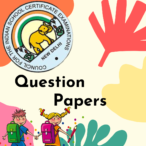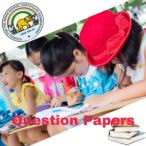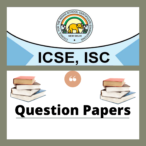GEOGRAPHY
H.C.G. – Paper – 2
PART I
![]() Q. 1 Study the extract of the Survey of India Map sheet No. 45D/7 and answer the following questions:
Q. 1 Study the extract of the Survey of India Map sheet No. 45D/7 and answer the following questions:
(a) Give the six figure grid reference for:
(i) ∆ 268
(ii) Temple south east of Khara
(b) Name the following:
(i) The drainage pattern seen in 9185.
(ii) The pattern of settlement seen in 9787.
(c) What do the following symbols mean?
(i) 3r in 9089.
(ii) 200 in 9383.
(d) Name two types of vegetation found in the region east of easting 93.
(e) Give two evidences which suggest that the rainfall received in the region shown on the map extract is seasonal.
(f) Calculate the area of the region between 85 – 90 northing and 90 – 95 easting. Give your answer in kilometer.
(g) Mention any two manmade features and two natural features in grid square 9080.
(h) What is the direct distance in kilometers between the surveyed tree west of Rampura (9580) to the chhatri in Juvol (9282)?
(i) Mention:
(i) The most commonly used means of transport in the area shown on the map extract.
(ii) The main occupation of the people of the region in the south eastern part of the map extract.
(j) (i) What is the compass direction of Rampura (9580) from Karja (9781)?
(ii) Identify the landform marked by contours in 9782.
![]() Q. 2 On the outline map of India provided:
Q. 2 On the outline map of India provided:
(a) Shade and label Thar desert.
(b) Label the river Narmada.
(c) Shade and name the Wular lake.
(d) Shade and label Kanara coast.
(e) Mark and name Mount Kanchenjunga.
(f) Shade and label a densely-populated region in India.
(g) Shade and label a region with Red soil in India.
(h) Mark with a dot and name Chennai.
(i) Mark and label the Arabian Sea branch of S.W. Monsoon.
(j) Mark with a dot and name Singhbhum.
Index No.……………………………………… UID………………………………….
(This map, if used, must be fastened with all other answers)
Map of India
PART II
![]() Q. 3 (a) How is the winter rainfall of the northwest part of India different from the winter rainfall of the southeast part of India?
Q. 3 (a) How is the winter rainfall of the northwest part of India different from the winter rainfall of the southeast part of India?
(b) (i) Name a state that is the first to experience the onset of the monsoon.
(ii) How does the “Mango shower” influence the state of Karnataka?
(c) Give a reason for each of the following:
(i) Kanyakumari experiences equable climate.
(ii) Central Maharashtra gets less rainfall than the coastal area of Maharashtra.
(iii) Jaipur has a higher annual range of temperature than Mumbai.
(d) Write three differences between summer monsoon season and retreating monsoon season.
![]() Q. 4 (a) (i) Why does alluvial soil differ in texture?
Q. 4 (a) (i) Why does alluvial soil differ in texture?
(ii) State two cash crops that grow well in alluvial soil.
(b) With reference to black soil answer the following:
(i) Name one important crop which grows in this soil.
(ii) Give one chemical property of this soil.
(c) Give one geographical reason for each of the following:
(i) Red soil requires irrigation.
(ii) Afforestation prevents soil from getting eroded.
(iii) Laterite soil is red in colour.
(d) (i) What is soil erosion?
(ii) Mention two causes of soil erosion in India.
![]() Q. 5 (a) (i) Name an area in India where Tropical Monsoon forest is found.
Q. 5 (a) (i) Name an area in India where Tropical Monsoon forest is found.
(ii) How is this forest of great commercial value to India?
(b) With reference to Littoral forest, answer the following questions:
(i) Why do the trees in this forest grow aerial roots?
(ii) Name one area in India where this forest is found.
(c) (i) Name a state in India where thorn and scrub forest is found.
(ii) Give two ways by which the trees that are found here have adapted to the climate.
(d) (i) Give two ways in which forests are important.
(ii) Mention one forest conservation method followed in India.
![]() Q. 6 (a) There is plenty of rain in India during the rainy season, yet we need irrigation.
Q. 6 (a) There is plenty of rain in India during the rainy season, yet we need irrigation.
Give two reasons to support this statement.
(b) (i) Name three traditional means of irrigation.
(ii) Give a reason why traditional means of irrigation are still important in most parts of India.
(c) (i) Differentiate between Surface water and Ground water.
(ii) Mention two reasons to explain as to why we are facing water scarcity in recent times.
(d) (i) What is rain water harvesting?
(ii) What are the advantages of rain water harvesting?
(iii) Name two water harvesting systems practised in India.
![]() Q. 7 (a) Give two advantages that non-conventional energy sources have over conventional energy sources.
Q. 7 (a) Give two advantages that non-conventional energy sources have over conventional energy sources.
(b) (i) Mention one advantage of the use of natural gas over coal or petroleum.
(ii) Name one off shore oil field of India.
(c) Answer the following:
(i) State one industrial use of copper.
(ii) Mention one advantage of generating power from bio-gas.
(iii) Name the mineral that toughens steel and makes it rust-proof.
(d) (i) Name the metal obtained from Bauxite.
Give any one use of the metal mentioned by you.
(ii) Which multi-purpose project provides power to both Punjab and Himachal Pradesh?
![]() Q. 8 (a) With reference to the cultivation of tea answer the following:
Q. 8 (a) With reference to the cultivation of tea answer the following:
(i) Why is tea grown on hill slopes?
(ii) Why tea bushes have to be pruned at regular intervals?
(b) With reference to rice cultivation answer the following:
(i) Why does the cultivation of rice require a lot of manual labour?
(ii) Mention two geographical conditions which suit the cultivation of rice.
(c) Give a geographical reason for each of the following:
(i) Cotton is a labour intensive crop.
(ii) Jute is retted after it has been harvested.
(iii) The growing of pulses is important in India.
(d) (i) Why is agriculture important in India?
(ii) Name the two main agricultural seasons of India.
(iii) What is mixed farming?
![]() Q. 9 (a) (i) Name the private sector iron and steel plant of India.
Q. 9 (a) (i) Name the private sector iron and steel plant of India.
(ii) From where does it get its supply of:
1. Iron ore
2. Manganese
3. Coal?
(b) Mention any two problems faced by the cotton textile industry of India.
(c) Give a geographical reason for each of the following:
(i) Silk industry is doing particularly well in Karnataka.
(ii) Petrochemical products are gaining popularity in modern times.
(iii) The electronics industry is proving to be an asset for our country in the Field of education.
(d) Name the following:
(i) A city most famous for electronics and hence called “The Electronics Capital of India”.
(ii) The location of an iron and steel industry set up with German collaboration.
(iii) A by-product of sugar industry which is used in the manufacture of wax and shoe polish.
![]() Q. 10 (a) Give two reasons for the “means of transport” being called the lifelines of a nation’s economy.
Q. 10 (a) Give two reasons for the “means of transport” being called the lifelines of a nation’s economy.
(b) Give two ways in which rail transport is useful for the people of India.
(c) (i) State one advantage of inland waterways.
(ii) State one advantage of roadways.
(iii) State one disadvantage of water transport.
(d) Give three reasons as to why airways are becoming a popular means of transport in modern India.
![]() Q. 11 (a) Give two reasons as to why there is a need for safe waste disposal.
Q. 11 (a) Give two reasons as to why there is a need for safe waste disposal.
(b) How can waste be reused? Explain with the help of an example.
(c) Mention one way in which waste accumulation has an effect on the following:
(i) aquatic life
(ii) terrestrial life
(iii) landscape
(d) What do you mean by the following terms?
(i) Segregation.
(ii) Composting.
(iii) Dumping.




